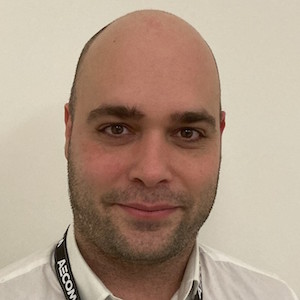
Harnessing data and machine learning will take the repetitive tasks out of engineering design, allowing designers to get more creative, says Andreas Galatoulas, data, analytics and AI director at Aecom.
The potential benefits of machine learning and AI, and equally the dangers, are played out in the media on almost a daily basis and in our everyday lives.
On the one hand, there are real fears that AI will displace millions of jobs, make it impossible to distinguish between real and fake news and, according to some of its developers, provide an existential threat if advancement goes unchecked.
On the other, AI is already revolutionising manufacturing, promising advancements in the care for the elderly, innovation in healthcare and pharmaceuticals and efficiencies across all industries, including design and construction and thus alleviating pressure on skills shortages.
Andreas Galatoulas, data, analytics and AI director at Aecom, acknowledges the bigger questions looming large over AI and how it might be regulated. But in design and construction – where the technology is still really in the foothills – harnessing AI can only bring benefit, he says.
As he sees it, there is no reason for engineering professionals to fear the application of this technology. His work is all about taking some of the repetitive tasks out of design and freeing up skilled engineers to do more stimulating and challenging work. In short, creating what Galatoulas describes as the ‘engineer of the future’.

“The engineer of the future will be someone who utilises data, digital and AI to focus on the task that really matters.”
What are his plans and how Aecom engineers and clients benefit from AI?
How did you get into this field?
I have been at Aecom for about two years, having worked with data across several industries, including publishing and insurance. My first degree was in maths. Following that, I did a Masters in Aeronautical Engineering – again mostly related to maths.
I’m a numbers person, so the way I describe my day job is ‘you give me numbers, I tell you stories’, using the data to understand what is happening and what is going to happen next.
What would an engineer of the future do?
The engineer of the future will be someone who, instead of focusing on repeating the same task again and again, utilises data, digital and AI to focus on the task that really matters. So rather than designing, let’s say, the same local flats every day when they have the same layout, they will be able to automate that process, and focus on designing buildings in a more interesting way.
What are you using AI for at the moment?
At Aecom, we are in the early stages of collecting and centralising data that can be used to automate processes, but we are also using AI on a number of projects. One of these is work we are doing with the Environment Agency to predict the severity of floods (see box right).
How AI is helping to predict flooding
Aecom is using AI to predict the severity and extent of floods by scanning and mapping data from historical photographs in a pilot scheme commissioned by the Environment Agency.
During a deluge, the Environment Agency often calls on the public to send in photographs of the affected area and, as a result, it has hundreds of thousands of records in its database, dating back decades. Many of the photographs have scant information about where they were taken and staff often just have to go through the photographs on picture by picture and compare them against Google maps, says Galatoulas.
The Aecom algorithms pick out identifying markers from the images, such as road signs or the types of buildings, to narrow down their location. When floods occur, pulling this information together allows the agency’s teams to judge how long flooding in an area will last and how severe it might become. In future, the data could be used during the conveyancing process for house searches and by the insurance industry.
In terms of design, we are trialling the automation of design of ancillary works, such as electric boxes.
So, we get information, we get all the historic designs of the build, we get the rules around the engineering and we sit down with the engineers and we start building a solution that can automate this process.
We currently work on processes like this internally and then with clients on a project-by-project basis.
Mostly internally, but also externally, people come to us with the problem and then my team – which has grown from a handful to 200 in two years covering Europe and India – will sit down with the experts and try to see how can make their life easier.
Most of the time AI will not do 100% of the work – it’s more like 60%-80%, the things that generally engineers don’t like doing. They can then add some sparkle on top and make it unique.
Project controls and programme management is another area of opportunity for Aecom to harness AI.
Within programme management, for example, most of the programme managers will be working with Excel spreadsheets that they copy/paste data from, taking it from different files. But on some major projects we have completely moved away from Excel spreadsheets and can produce visualisations of key project controls without any human interaction. So, for example, if a project team has a budget of X and that is being spent, but the work is not delivered to schedule, we can automatically trigger an alert to the project directors and project managers to help them identify what the issue is.
Are you writing your own software or using off-the-shelf?
Both. We do not try to reinvent the wheel and most of the time we try to support the open-source communities. We are platform agnostic, so if something has already been done by Microsoft or by Google or by Amazon or by Facebook say, we’ll use it.
Most of the projects we’re working on will be a hybrid of off the shelf and our own software.
“Engineers will be adapting to change and continually learning, so that they can spend more time automating the design themselves.”
How long do you think it will take for machine-assisted design to become the norm in construction?
In three years, there will be a significant change because the industry will be populated by graduates who have grown up with new technology – smart phones, tablets – and who do things on a mobile phone and would not expect to have the big desk to do their designs. I think they will drive change.
I would say that engineers will be adapting to change and continually learning, so that they can spend more time automating the design themselves. So rather than someone from a specialist data/AI team working with them, this would become part of their job.
It is not about making the designer redundant, it’s about making my role redundant because the designer will be able to do the design plus my role.
My role is having to continually adapt to change and evolve – and that is increasingly how it will be for the design professions. Those who do not adapt will be left behind.
I think there is a lot of scaremongering about AI and data. We need to focus on the exciting things that will come out of it.
Don’t miss out on BIM and digital construction news: sign up to receive the BIMplus newsletter.












